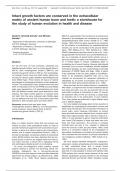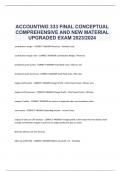Biol. Chem., Vol. 386, pp. 767–776, August 2005 •Copyright /H17050by Walter de Gruyter •Berlin •New York. DOI 10.1515/BC.2005.090
2005/160Article in press - uncorrected proof
Intact growth factors are conserved in the extracellular
matrix of ancient human bone and teeth: a storehouse for
the study of human evolution in health and disease
Tyede H. Schmidt-Schultz1and Michael
Schultz2,*
1Department of Biochemistry, University of Go ¨ ttingen,
D-37075 Go ¨ ttingen, Germany
2Department of Anatomy, University of Go ¨ ttingen,
D-37075 Go ¨ ttingen, Germany
* Corresponding author
e-mail: mschult1@gwdg.de
Abstract
For the first time we have extracted, solubilized and
identified growth factors, such as insulin growth factor II
(IGF-II), bone morphogenetic protein-2 (BMP-2), and
transforming growth factor- b(TGF- b), from archaeologi-
cal compact human bone and tooth dentin dating from
the late pre-ceramic pottery Neolithic (late PPNB) and the
early Middle Ages. These factors are typical of special
physiological or pathological situations in the metabolism
of bone. The extracellular matrix proteins from bone and
teeth of individuals from the late PPNB and early Middle
Ages were separated by 2-D electrophoresis and more
than 300 different protein spots were detected by silver
staining. The matrix protein patterns of compact bone
and tooth from the same individual (early Middle Ages)
are very different and only 16% of the protein spots were
detected in both compact bone and tooth dentin.
Keywords: ancient bone and teeth; bone
morphogenetic protein-2 (BMP-2); 2-D electrophoresis;
human evolution; insulin growth factor II (IGF-II);
transforming growth factor- b(TGF- b).
Introduction
Bone is a highly dynamic tissue that has evolved over
millions of years under gravitational stress on Earth to
provide mechanical support for both locomotion and pro-
tection, to serve as a calcium reservoir for mineral home-
ostasis, and to support hemopoiesis (Einhorn, 1996). In
the last two decades, increasing numbers of extracellular
matrix (ECM) proteins have been detected that are pro-
duced locally in bone or are trapped within the hard tis-
sue matrix and play a critical role in regulating normal
and pathological skeletal growth and remodeling.
For some non-collagenous matrix proteins, several
aspects relating to function are becoming clearer. For
example, osteopontin has a Gly-Arg-Gly-Asp-Ser
(GRGDS) amino-acid sequence that promotes osteoclast
attachment via cellular integrin avb3(Reinholt et al., 1990;
Heinegard et al., 1995). Bone alkaline phosphatase(BALP) is a glycoprotein that functions as an ectoenzyme
attached to the osteoblast cell membrane by a glycosyl
phosphatidylinositol (GPI) anchor (Fedde et al., 1988;
Hooper, 1997). BALP has been reported to be necessary
for the initiation of mineralization by osteoblast-derived
vesicles, but not for continuation of the process (Tenen-
baum, 1987; Bellows et al., 1991; Barling et al., 1999).
SPARC (osteonectin) has been shown to be a Ca2q-bind-
ing glycoprotein that functions as a counteradhesive pro-
tein, as a modulator of growth factor activity, and as a
cell-cycle inhibitor. In adults, the expression of osteonec-
tin is limited largely to tissues undergoing repair or
remodeling due to wound healing. However, pathological
processes, such as cancer metastasis, arthritis, diabetes
and kidney diseases, are also characterized by elevated
expression of SPARC (Reed and Sage, 1996). It seems
to be expressed in the very early stages of cell differen-
tiation or by osteoblast progenitor cells and it may
maintain an environment for sequential maturation of
osteoblasts by its protein accumulation and matrix for-
mation with other gene products (Ibaraki et al., 1992).
Bone and teeth are the hardest tissues in vertebrates.
After death, a corpse that has not been embalmed leaves
only bone and teeth, as a rule, as remnants that can be
found after hundreds or thousands of years. Of course,
the protective effect of the soil covering a corpse plays
an important role in the preservation of such material.
Thus, bony tissues are preserved in highly different ways
and to different degrees.
Our most reliable knowledge about human evolution is
established by morphological examinations of bone and
teeth using macroscopic and microscopic techniques. In
recent years, some molecular information on ancient
bone and teeth has been obtained from extracted short
DNA chains (approximately 200 or 300 bp; Krings et al.,
1997). It is now possible to gather molecular information
from intact ECM proteins of bone and teeth from sub-
fossil and fossil specimens. The turnover in compact
(cortical) bone per year is 4%, whereas in trabecular
bone the turnover is 28% per year (Parfitt, 1994). Tooth
dentin is a convenient material for the investigation of
age-related modifications of proteins and certain studies
have indicated that this reaction is primarily restricted to
non-collagenous proteins (Masters, 1985; Kuboki et al.,
1984).
We have already identified osteopontin, osteonectin,
osteocalcin, alkaline phosphatase and bone sialoprotein
in fresh, macerated bones and in ancient bones
(Schmidt-Schultz and Schultz, 2004, 2005). It is remark-
able that it is also possible to extract and identify intact
ECM proteins from ancient bones because of the more
efficient solubilization process inherent in this technique
(Schmidt-Schultz and Schultz, 2004). Therefore, protein 768 T.H. Schmidt-Schultz and M. SchultzArticle in press - uncorrected proof
separation has been improved and there is a better guar-
antee of identification by specific antibodies.
Bone has a remarkable regenerative potential that en-
ables it to remodel itself in response to changing physical
demands and to repair itself after injury. Important for the
process of remodeling and self-repair are growth factors.
Several growth factors, such as transforming growth fac-
tor-b(TGF- b), bone morphogenetic proteins (BMPs) and
insulin growth factors (IGFs) have clear functions in the
regulation of bone formation during the healing process,
for example, after fracture (Andrew et al., 1993; Mundy
1993; Taniguchi et al., 2003).
BMPs are members of a class of ancient highly con-
served signaling molecules that play major roles in
embryonic axis determination, organ development, tissue
repair, and regeneration throughout the animal kingdom
(Kaplan and Shore, 1998). BMPs were discovered
because of their ability to induce cartilage and bone for-
mation from non-skeletal mesodermal cells and are now
of considerable interest as therapeutic agents for healing
fractures and periodontal bone defects (Urist, 1994; Nie-
derwanger and Urist, 1996).
IGFs stimulate osteoblast cell proliferation and differ-
entiated functions, such as type I collagen expression
(Canalis et al., 1993). Furthermore, besides its mitogenic
effects, the IGF peptide increases the production of sev-
eral bone matrix proteins, stimulates collagen type I
expression, and inhibits collagen degradation, possibly
through down-regulation of collagenase expression, and
induces alkaline phosphate expression (Langdahl et al.,
1998).
TGF-bhas been observed to both inhibit and stimulate
osteoblast cell proliferation, in part depending on TGF- b
concentration, species and stage of osteoblast differen-
tiation (Centrella et al., 1994). The amount of TGF- bin
human bone declines with age (Nicolas et al., 1994). It is
proposed that latent TGF- bin the bone cell microenvi-
ronment is activated by acidic conditions, which develop
beneath the ruffled border of active osteoclasts (Centrella
et al., 1994), and by proteolytic compounds of the plas-
minogen system (Yee et al., 1993). Similar to the IGFs,
TGF-bexpression in periosteal tissue rapidly increases
with external mechanical loading (Raab-Cullen et al.,
1994).
Many molecules, whether produced locally or exoge-
nously, are adsorbed on to bone hydroxyapatite during
life. Mineralizing bone provides an excellent system for
the sequestration and subsequent immobilization of
molecules normally soluble in physiological fluid.
This junkyard-like property of bone can be quite
advantageous if the sequestered molecules afford bene-
fits to the tissue, either in its normal physiology or under
stress. The sequestered proteins, which are entrapped in
the ECM of bone during its lifetime, can be solubilized
using the method described by Schmidt-Schultz and
Schultz (2004) not only for recent bone, but also for
bones that are thousand of years old. Thus, we have
extracted, solubilized and identified growth factors, such
as IGF-II, BMP-2, and TGF- b, conserved in archaeolog-
ical human bone and teeth that are typical of special
physiological or pathological situations in the metabolism
of bone and teeth, dating from the late pre-ceramic pot-tery Neolithic (late PPNB) and early Middle Ages. The
identification of ECM proteins in ancient bones and teeth
is an important approach in the field of molecular paleo-
pathology. This is a new field of research in which mol-
ecules are used to confirm the presence of disease in
past populations. It is this field that will contribute to our
study of the history of diseases, their frequency over the
course of time, and the evolution of disease.
A precondition for biochemical analysis is that archae-
ological bone samples are primarily controlled by micro-
scopic techniques (histology) to exclude changes due to
postmortem processes (diagenesis), which might dam-
age the microstructure of the original bone substance
significantly and might also lead to false biochemical
results (Schultz, 1997; Schmidt-Schultz and Schultz,
2004). Thus, the first step in identifying proteins in recent
and especially in archaeological bone samples is to
establish the preservation state of organic and inorganic
bone structures. This is carried out microscopically by
viewing thin ground sections in plane and polarized light.
In this way, contamination and destruction caused by
decomposition (destruction of organic structures) and
diagenesis (destruction of inorganic structures) in ancient
bone can be detected and ruled out (Schultz, 1986,
1997; Hansen and Buikstra, 1987; Schoeninger et al.,
1989). If there is no contamination and destruction due
to plant roots, fungi, algae, bacteria, arthropods, etc., the
sample is suitable for protein extraction (Figure 1).
The aim of this study is to demonstrate the extraction,
solubilization and identification of growth factors that are
typical of special physiological or pathological situations
in bone metabolism from archaeological human skeletal
remains. Furthermore, for the first time, differences in the
ECM protein patterns of human bone and tooth dentin
from the same individual are demonstrated by two-
dimensional electrophoresis.
Results
Protein extraction and separation of bone and tooth
proteins
ECM proteins were extracted from samples of human
compact (cortical) bone substance and tooth dentin tak-
en from a recent individual and from archaeological spec-
imens dating from the late PPNB and the early Middle
Ages (Table 1). These samples and recent human bone
and tooth dentin used as controls were examined using
silver-stained 1-D-electrophoresis (SDS-PAGE). A clear
protein pattern of approximately 25–30 colored bands in
the molecular mass range of about 10–150 kDa was
observed (the detection limit for silver is in the range
1–10 ng of protein). Figure 2 (lane 1) shows ECM proteins
of the compact bone substance of a recent adult individ-
ual. In lane 2, the protein pattern of dentin (tooth 31) of
a recent juvenile individual is presented. Lane 3 (compact
bone substance) and lane 4 (dentin of tooth 13) display
ECM proteins of an adult individual from Barbing (early
Middle Ages, 450–600 AD). The proteins shown in lane
5 (compact bone substance) and lane 6 (dentin of tooth
27) were extracted from an adult individual from Basta,
a late PPNB site in Jordan (7500–6000 BC). It is striking





